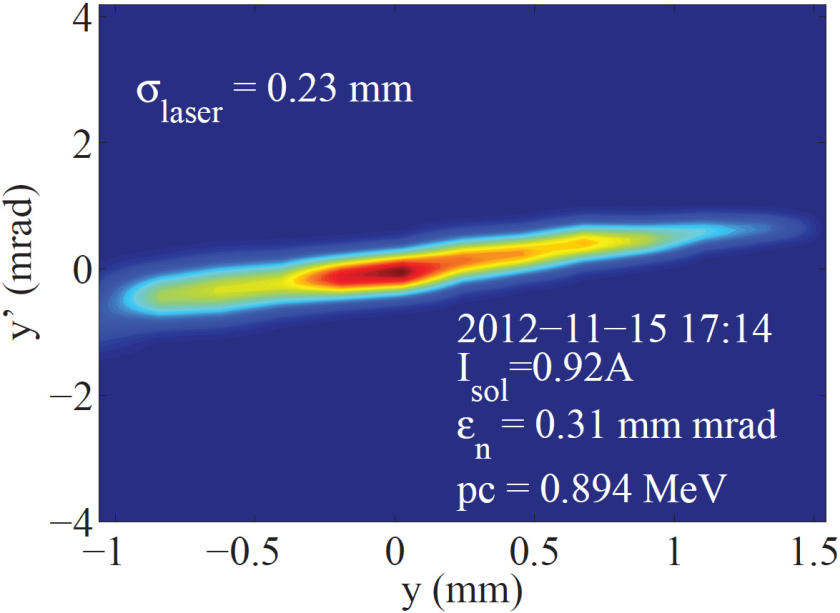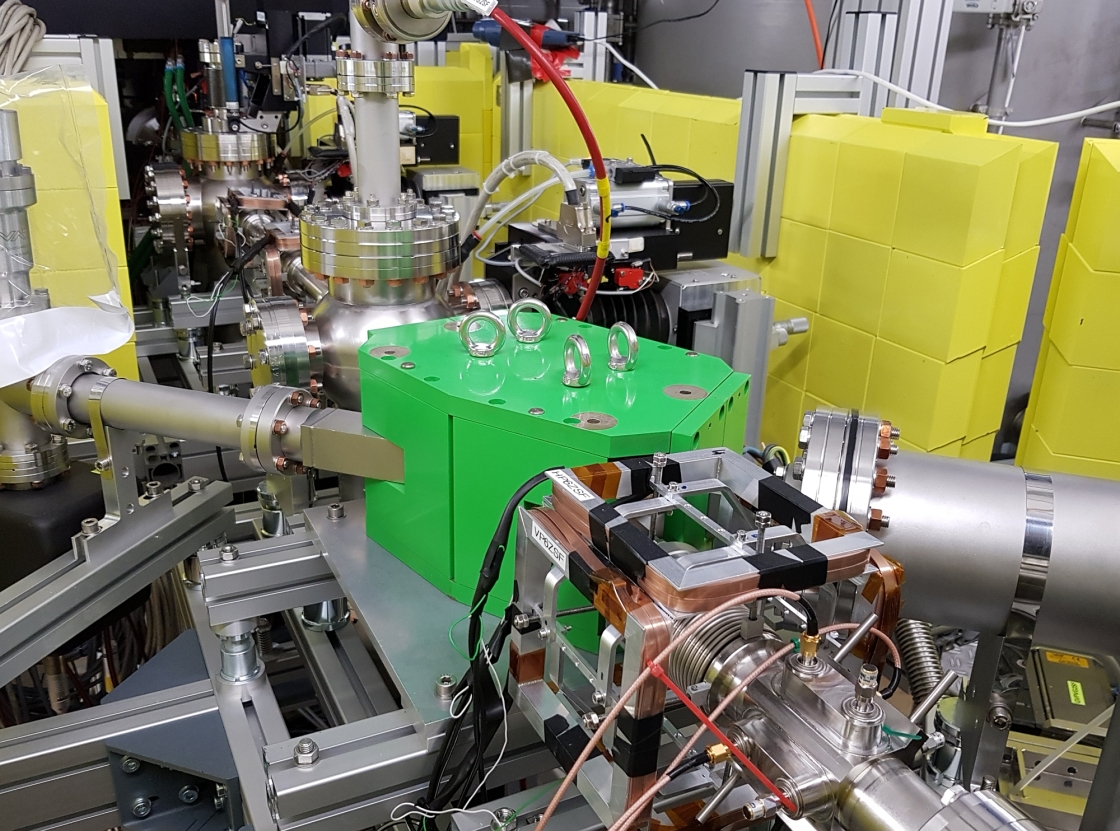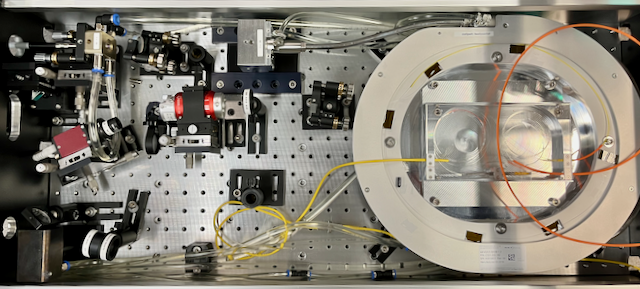Department High Brightness Beams
Accelerators
High Brightness Beams (BE-AHBB)
Head: Prof. Dr. Thorsten Kamps ORCID JACoW
Deputy: Dr. Julius Kühn
Particle accelerators play a fundamental role within the modern research and development era, advancing such varied fields as the future of energy, health and our industry. The development of novel accelerator concepts already today gives science impulses for the exploration of new research fields and will be indispensable in the future. The development of innovative particle sources with extreme performance parameters such as high beam current, low emittance, variable pulse length or selectable polarization is the main task for future accelerators.
The goal of our research is to understand the fundamental limits of beam brightness in electron sources, electron guns and accelerators. We approach this goal from various angles: they range from photoemission studies via beam dynamics investigations to experiments with electron accelerators.
Physics and Applications of High Brightness Beams
Many future applications of electron injectors like free electron lasers (FEL, energy-recovery linacs (ERL), or direct beam sources for ultrafast scatering require continuous wave operation of extremely bright and short electron pulses. To push the development of SRF photoinjectors are working on the photoemission electron sources, the photocathode and the photocathode drive laser, as well as on the beam dynamics of space-charge dominated beams. We complement the activities with the development of beam instrumentation tools to understand and optimize the performance of such sources. For this we develop non-destructive beam size monitors for ERL and laser-plasma accelerators. Furthermore we look into the deployment of SRF photoinjectors for ultra-fast sciences. For example for ultra-fast electron diffraction or ultra-fast electron microscopy.
Publications and Talks
- B. Alberdi Esuain, J.-G. Hwang, A. Neumann, T. Kamps, Novel approach to push the limit of temporal resolution in ultrafast electron diffraction accelerators, Sci Rep 12, 13365 (2022)
- J.-G. Hwang, M. Abo-Bakr, A. Matveenko, G. Kourkafas, T. Kamps, Radiation Generation with an Existing Demonstrator of an Energy-Recovery Continuous-Wave Superconducting RF Accelerator, Journal of the Korean Physical Society 77 (5), 337-343
- T. Kamps et al., Scientific opportunies for bERLinPro 2020+, report with ideas and conclusions from bERLinProCamp 2019, arXiv:1910.00881 [physics.acc-ph]
- T. Kamps et al., SRF Gun Development for Energy Recovery Linac Applications, Compact EUV & X-ray Light Sources 2016. OSA
- R. Barday et al., Characterization of a Superconducting Pb Photocathode in a Superconducting RF Photoinjector Cavity, Phys. Rev. ST Accel. Beams 16, 123402 (2013).
- M. Abo-Barkr et al., Nonlinear harmonic generation in the STARS FEL, Nuclear Instruments and Methods in Physics Research Section A, 593, 1-2, 6, (2008).
Photoemission Sources - Photocathode Research & Development for Electron Accelerators
The beam quality of a SRF photoinjector in terms of brightness and current is ultimately given by the electron source itself. In an SRF photoinjector electrons are generated by illuminating a photocathode with light pulses from a drive laser. This photocathode must be embedded into the SRF cavity, such that the electrons can be quickly accelerated to mitigate space charge effects. The focus of the activities is to understand correlations between cathode material, preparation, treatment and electron beam parameters such as transverse emittance, which is linked to the brightness of the beam generated with the SRF photoinjector. Our goal is to provide high quantum efficiency multi-alkali Cs-K-Sb and Na-K-Sb photocathodes for the operation of SRF photoinjectors. Beyond the application driven research we are also committed to understand photoemission materials on a fundamental level.
Publications and Talks
- J. Dube at al., Triple Evaporation of Bialkali Antimonide Photocathodes and Photoemission Characterization at the PhoTEx Experiment. preprint at arxiv
- C. Cocchi et al., Electronic structure and core electron fingerprints of caesium-based multi-alkali antimonides for ultra-bright electron sources, Scientific Reports, 9, 18276, (2019). SR
- M. A. H. Schmeißer et al., Towards the operation of Cs-K-Sb photocathodes in superconducting rf photoinjectors, Phys. Rev. Accel. Beams 21, 113401, (2018). PRAB
Beam Instrumentation
Beam instrumentation plays a crucial role in every phase of an accelerator project. Diagnostics are essential during checkout and startup to achieve the target beam parameters. They aid in debugging the accelerator and identifying sources of performance deviation from the optimal setup. Therefore, the focus must be on straightforward, rapid, and easy-to-interpret measurement techniques and procedures for the entire phase space. This includes the core beam, the tails in the distributions, and dark current. Currently, we are developing specialized electron beam instrumentation for the SRF photoinjector of the SEALAB accelerator and external accelerators like Athena_e. Examples include a rapid emittance scanner, a compact spectrometer dipole for photoinjector beams, a transverse deflecting RF cavity at 1.3 GHz, and the development of an interferometric beam size monitor adapted for low-intensity applications. The transverse deflecting cavity has now been transferred to industry. In this context, our efforts are driven by extreme beam parameters and innovative solutions.
Publications and Talks
- J.-G. Hwang, K. Albrecht, A. Hoehl, B. Alberdi Esuain, T. Kamps, Monitoring the size of low-intensity beams at plasma-wakefield accelerators using high-resolution interferometry, Communications Physics 4, 214 (2021)
- G. Kourkafas et al., TRANSVERSE DEFLECTING CAVITY FOR LONGITUDINAL BEAM DIAGNOSTICS AT bERLinPro, Proceedings of LINAC2018, Beijing, China, pp. 875. JACoW.org
- J. Völker, Development of a compact test facility for SRF Photoelectron injectors, PhD-Thesis, Humboldt Universtität zu Berlin, Germany, (2018). HUB
- G. Kourkafas et al., SOLENOID ALIGNMENT FOR THE SRF PHOTOINJECTOR OF bERLinPro AT HZB, Proceedings of IPAC2017, Copenhagen, Denmark, pp. 1778. JACoW.org
- T. Kamps et al., Electron beam diagnostics for a superconducting radio frequency photoelectron injector, Review of Scientific Instruments 79, 093301 (2008).
- A. Bosco et al., A two-dimensional laser-wire scanner for electron accelerators, Nuclear Instruments and Methods in Physics Research Section A: 592, 3, 162 (2008).
Drive Laser and Laser Beam Transport
The operation of an SRF photoinjector requires a dedicated drive laser to extract electrons from the photocathode. The photoemission process occurs on such a short time scale that the bunch duration is close to the duration of the laser pulse, even in the ps—of the fs regime. Therefore, the temporal characteristics of the electron bunches can simply be controlled by shaping the laser pulses accordingly and by providing a suitable pulse pattern. The optical pulse energy and the transverse shape and location of the laser spot on the photocathode influence space charge effects, beam dynamics, and emittance. However, the cathode's quantum efficiency depends on the wavelength of the laser radiation. Our drive laser systems are developed in collaboration with the Max-Born Institute. The focus of the work in our department is developing an optical transport and diagnostics system, which transports the laser pulses onto the cathode and controls the laser pulse properties at the photocathode. It is desirable to provide some flexibility concerning the transverse shape for the optical pulse energy and the pulse pattern to meet the specifications of the various operation modes of the photocathode.
Publications and Talks
- E. Panofski et al., Virtual Cathode Drive Laser Diagnostics with a Large Dynamic Range for a Continuous Wave SRF Photoinjector, Proceedings of IPAC2014, Dresden, Germany, pp. 2251 JACoW.org
- M. Gross, G. Klemz et al., Laser Pulse train management with an Acousto-optic modulator, Proceedings of FEL 2012, Nara, Japan, pp. 189 JACoW.org
- I. Will and G. Klemz, Generation of flat-top picosecond pulses by coherent pulse stacking in a multicrystal birefringent filter, Optics Express 16, 14922-14937 (2008) DOI:10.1364/OE.16.014922
- I. Will and G. Klemz, Drive lasers for photoinjectors, Proceedings of ERL 2007, Daresbury, UK, pp. 1 JACoW.org
- G. Klemz and I. Will, A Beam Shaper for the Optical Beamline of RF Photoinjectors, Proceedings of FEL 2006, Berlin, Germany, pp. 53 JACoW.org




